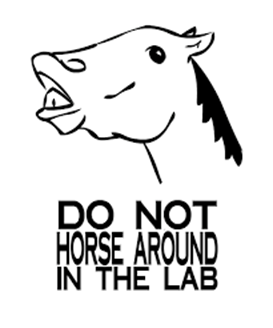Team:UChicago/Safety
Safety


Our lab is a WHO BSL1 Lab, a low risk lab. We use a range of equipment from open areas, to laminar flow hoods, as well as standard lab safety practices. Cells cultures are killed with bleach before disposal, and general solid waste is collected into biohazard bags and disposed of.
All team members received training on biosafety levels, requirements for laboratory practices and equipment, biohazard containment, recombinant DNA, bioethics, fire safety, and personal protective equipment. Our institution's safety training policies are available here.
At our institution, we are supervised by the University of Chicago Office of Environmental Health and Safety. They provide a form as a guide to safety here. We are also under US law, which provides other guidelines here.
All of the strains that we are using are in risk group 1, with the potential to cause irritation, or affect kidneys
Specific safety concerns and responses include:
- E. coli MG1655 and DH5a, which belong to risk group 1 and may pose the following risks: irritation to skin, eyes, and respiratory tract, may affect kidneys. All plates and cultures are disinfected with bleach after use, and the lab benches are wiped down in 70% EtOH and then dH2O to prevent contamination.
- Some toxic or harmful chemicals such as ethidium bromide, chloroform and bleach. Team members are required to wear rubber gloves at all times in labs, and lab coats when handling harmful chemicals.
- Other flammable chemicals such as isopropyl ethanol, ethanol, DMSO will be handled with care and jf spilled, the liquids will be soaked up and the lab bench or any affected areas will be wiped down and cleaned.
- Hazardous waste such as chloroform waste are collected in special waste bins in the lab that will be treated by the University's hazardous waste disposal contractor.
- All members are required to take the biosafety lecture and a lecture on fire safety held by the University. All members have had experience in lab work and have had online trainings on safe lab practices.
- We hold weekly meetings with faculty and graduate student advisors such that experienced wet lab scientists can provide advice and feedback on safe lab practices. Moreover, all of our team members have had lab experience before so that we can reduce the risk of human error. We have also chosen a harmless lab strain of E. coli to prevent the risk of introduction or spreading of harmful organisms. On a day to day basis, Justin Chew, one of our grad advisers who works in the lab bench next to us, is on hand to help us with any difficult wet lab protocols or emergencies that might arise.
- All our expressed proteins in this proof-of-concept project are relatively harmless and nontoxic, and used well-known, safe lab protocols for our assays. In our Human Practices page, we discuss the possibility of having to add a kill switch much later down the road if a functional system is created in future years.
- We sent our DNA submissions as dried down DNA in the mail, and didn’t encounter any problems with trying to submit them.
Like our team Facebook page, Genehackers@UChicago!
Questions? Comments? Send us an email!
